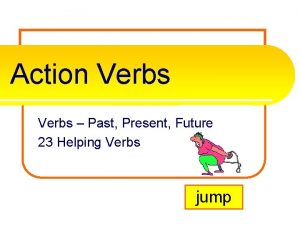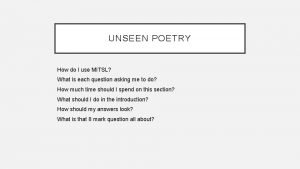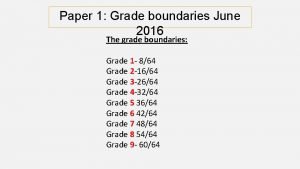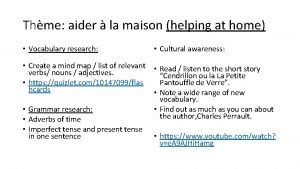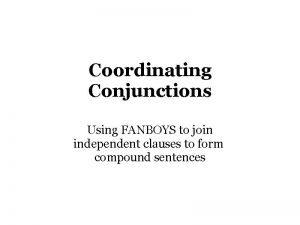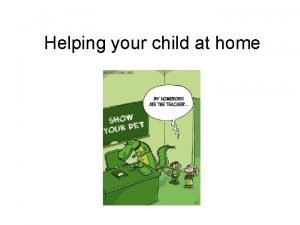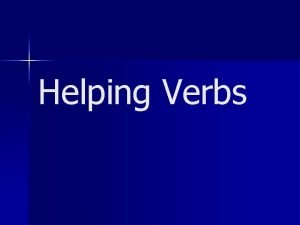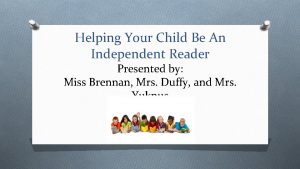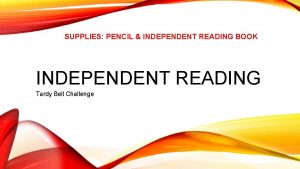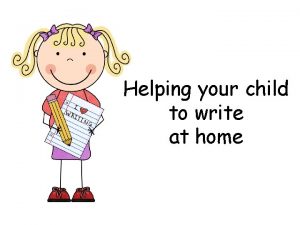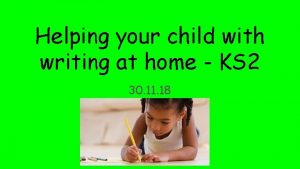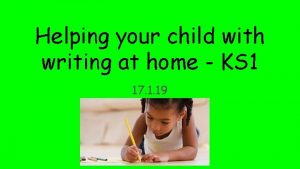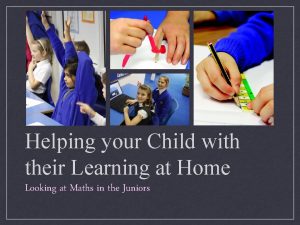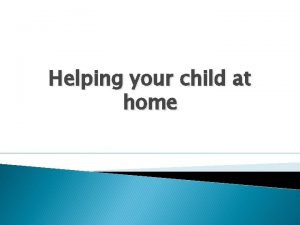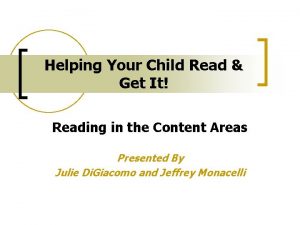Helping your child at home towards Independent Reading














- Slides: 14

Helping your child at home towards Independent Reading

Logistics Book bags need to be in school everyday. Books will be changed Monday-Thursday. It may be a different day each week it will very much depend on times where adults need to be for learning purposes/for cleaning. One book a week but you can use the e-books available online as well as using your own picture books at home. https: //www. oxfordowl. co. uk/for-school/oxford-owl-ebookcollection You need to read the books more than once to enable your child to apply and practise their skills.

Speaking and Listening. Listen to and encourage talking. Model good listening - looking at the person who is speaking/responding appropriately/ be a good listener when your child is reading to you. Be a good role model for speaking. - repeat what your child has said but correctly if they pronounce something incorrectly or use the wrong tense.

Reading is everywhere Model reading – read everything and anything out loud so your children see how important it is in everyday and why they are learning to do it. Signs Books Newspapers Instructions –building/ cooking/cleaning/ baking. House names I could name many more!

Types of books Picture books First words Repetitive language. Decodable text. Books that require using the picture and/ or initial sounds to help your child decode the unfamiliar text.

Phonics Follow Df. E Letters and Sounds. Use elements of Jolly phonics as children like the songs. Learn through games and activities. In small groups. Home Learning Phonics flashcards (please keep at home) Games and ideas for how to use them are provided. Please if you get stuck/confused how to help next email classr 20@crowmarsh-Gifford. oxon. sch. uk.

Phonics v

Phase 1 games Listening (environment sounds) Discrimination between sounds - instrument sounds. Discrimination between sounds – body percussion Rhythm and rhyme Alliteration Voice sounds Oral Blending/ segmenting Help at home by playing games such as these as much as possible.

Phase 2 Children have started to be introduce to phase 2 this week. Still continue phase one games. Begin to learn the sets of letters within phase 2. starting with s, a, t, p, i, n. Learning to blend to read CVC words and segment to spell CVC words. (magnetic letters are helpful for many children) Learning tricky words. Reading two syllable words and reading simple captions.

Phase 3 Children are introduced to phase three when they are secure within phase 2. Introduced to another 25 graphemes most of which are digraphs (two letters making one sound) Tricky words (these just have to be learnt by wrote) Flashcards and games will be sent home to help with this.

Teaching Reading strategies. Talking about book language – Author, Illustrator, Title, front cover, back cover, blurb, word, letter, sentence, full stops, capital letters. Using the pictures/ illustrations to help them with creating a story/ building a picture of what is happening in the book. Using initial sounds in words. Using the context of the book/ what they are seeing. Encouraging them to read on to the end of the sentence when they do not know what the word is (come back to the world) Make links with their reading “oh we saw this word in the book we were reading yesterday/on that shop sign etc) / the same thing happened in/ that reminds me of the story…. Learning words by wrote and applying them in many different context. Using their understanding of the spoken language and patterns of language. Using their comprehension of the whole text to help them decoding unfamiliar words. Encourage recognition when words/phases are repeated. They will not be doing everything all at once but begin to grow their reading strategies generally starting with blending and using pictures.

Book Sharing! Please ask questions as we go along.

How to help Daily reading practise Praise/ encouragement. Support your child – initially this will be modelling and commenting. Then moving onto questioning what could you do if you’ve tried…. . Working towards your child independently using these various skills /a range of skills to decode an unfamiliar text. The aim is for your child to read books fluently without the need for blending every / majority of words. We would like your child to read books and be aware of their listener. Adding expression and interest as they read.

Find a time that suits your child. Make it enjoyable. If they are not engaging and it’s become a battle, stop and talk to us about it. If you are finding regular reading at home tricky for various reasons then please let us know. Please ensure that you write (just date and a brief comment) in the reading record this really helps us support your child with their next steps in reading. Have fun with reading!
 Helping verbs 23
Helping verbs 23 When your child leaves home poem
When your child leaves home poem The skin cracks like a pod
The skin cracks like a pod Www.quizlet.llve
Www.quizlet.llve While reading activities
While reading activities Help your mother
Help your mother Fanboys connectors
Fanboys connectors Ohio home care waiver conditions of participation
Ohio home care waiver conditions of participation Perbedaan home care dan home service
Perbedaan home care dan home service Perbedaan home care dan home visit
Perbedaan home care dan home visit New mobile home sales oak springs mobile home community
New mobile home sales oak springs mobile home community Unit 1 home sweet home
Unit 1 home sweet home Come home come home jesus is calling
Come home come home jesus is calling Oak springs rv park
Oak springs rv park Let's go to my house
Let's go to my house
